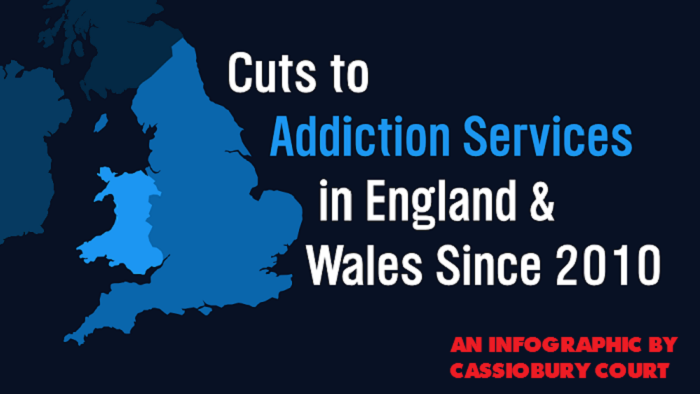Cuts to Addiction Services Since 2010 [INFOGRAPHIC]


John Gillen - Author | Last Updated: 7th April 2025
Posted on Tuesday, July 25, 2017 at 4:31 pm

In this blog post, we unveil our latest infographic titled “cuts to addiction services in England and Wales since 2012”. Since 2010, successive Tory Governments have aimed to save public money by cutting addiction services. Since addiction is often stigmatised, perhaps these politicians feel justified in cutting these unarguably essential services.
These cuts really started to take hold following the enactment of the Health and Social Care Act 2012. This Act meant addiction services is now solely commissioned by local authorities and not the NHS.
Before 2012, long term Government investment in addiction services saw year-on-year decreases in drug-related deaths. These improvements have now been utterly wiped out.
Why is this the case? Because under the NHS, local authorities’ spending on addiction treatment isn’t ring-fenced. Most local authorities have seen their own budget reduced by the Government, and so addiction services have been chopped to help local authorities make savings required by these cuts.
An example of this injustice is in the City of Birmingham. Addiction services saw their budget cut from £26m to £19m in 2015-16.
Following the enactment of the Health and Social Care Act 2012, drug-related deaths have sharply increased:
Sadly, these increases have occurred despite an overall decrease in the number of people using illicit drugs. In 2005/06, 10.5% of adults aged 16 to 59 had taken an illegal drug in the last year. This decreased to 8.4% in 2015/16.
Staffing levels have been hit hardest by these cuts. Staffing cuts mean fewer psychiatrists, psychiatric nurses and clinical psychologists are available to assist people suffering from addiction issues. Addiction services are instead of relying on doctors without specialist qualifications and volunteers.
The number of trainee addiction psychiatrists have reduced by 60% since 2006. In 2006, there were 52 trainee psychiatrists. In 2016, this number has decreased to 21. This means addiction services find it difficult to access sufficiently qualified staff members. This has decreased the quality of addiction services and diminished the safety of client care.
Harm reduction is used to describe the methadone programme. This is when those addicted to heroin are given methadone as a ‘replacement’. Whilst the merits of this approach are debatable, thousands of people have come to depend on methadone to control their addiction to opiates, and going without really forces these people back onto street heroin.
Since 2012, local authorities have begun to limit the number of time clients may stay on a methadone programme. Also, ‘payment by results’ contracts mean many local authorities are unwilling to offer the methadone programme to clients with complex mental health needs.
The above state-of-affairs means many people are seeking out the assistance of A&E instead of specific addiction services. The number of hospital admissions in 2015/16 relating to drug poisoning was 15,074. This represents a 51% increase compared to 2005/05.
The Royal College of Psychiatrists proposes a three-part solution:
Below, we unveil the infographic visually representing the above facts. At the footer of the infographic, there is an embed code. You may copy this code to insert this infographic into a blog post on your own website.

If you control a website, we would appreciate it if you could link to this infographic. You could perhaps add the link to your ‘useful links’ page, or embed the infographic in a blog post. This link will help to inform others of the important information contained in this infographic.
Below, we list the references we used when compiling the above infographic:

John Gillen - Author Last updated: 7th April 2025
John Gillen is a leading addiction treatment expert with over 15 years of experience providing evidence-based treatment methods for individuals throughout the UK. John also co-authors the book, The Secret Disease of Addiction, which delves into how the addictive mind works and what treatment techniques work best.